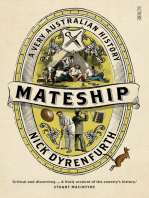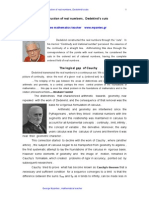Thomas Pynchon
Thomas Pynchon
Uploaded by
Angela91Copyright:
Available Formats
Thomas Pynchon
Thomas Pynchon
Uploaded by
Angela91Original Description:
Copyright
Available Formats
Share this document
Did you find this document useful?
Is this content inappropriate?
Copyright:
Available Formats
Thomas Pynchon
Thomas Pynchon
Uploaded by
Angela91Copyright:
Available Formats
Thomas Pynchon (b.
1937)
Main Works: V., 1963; The Crying of Lot 49, 1966; Gravitys Rainbow, 1973; Slow Learner, 1984; Vineland, 1990; The Teachings of Don Ban Introduction to the 1992 Donald Barthelme Collection; Mason & Dixon, 1997; an Introduction to the Penguin Books Centennial Edition of George Orwells Nineteen Eighty-Four, 2003; Against the Day, 2006; Inherent Vice, 2009. Thomas Pynchons stories and novels are certainly dependent on the metaphors and language of the hard sciences, as, for instance, the second law of thermodynamicsNature prefers disorder, chaos as this may lead to a state of equilibrium, which is applied to the early story Entropy; the idea of a dynamic theory of history, taken over from the novelist Henry Adamss The Education of Henry Adams, is adapted to how the whole cluster of technologies contributing to the development of the V-2 rocket bomb influence the destinies of Pynchons characters in Gravitys Rainbow (1973); In The Crying of Lot 49 (1966), the physicist James Clerk Maxwells fabled Demon is a model for the investigative activities of the novels heroine, Oedipa Maas; Emersons moral and theological doctrine of compensation drawing on the principle in physics that every action implies an equal and opposite reaction is used by Pynchon in the last section of Vineland (1990). Pynchon shares with Rabelais, Swift and Laurence Sterne, the tradition of learned wit, wherein high erudition exists alongside bawdy and often scatological comedy. He owes to the gothic novel an interest in horror and the occult, and a general hostility to rationalism. He also had the same concerns as the Beat Generation (1940-50), all being more than suspicious about the techno-political order considered the greatest threat to tradition. The recurring theme in all his writings is the degeneration of the human fiber and the degradation of the democratic dogma. Pynchon writes about Entropy in his introduction to Slow Learner (1984): The story is a fine example of a procedural error beginning writers are always being cautioned against. It is simply wrong to begin with a theme, symbol or other abstract unifying agent, and then try to force characters and events to confirm to it. Callisto, one of the two characters in the story, will adapt the idea that nothing but a theoretical engine or system ever runs at 100% efficiency; and that the entropy (or inefficiency) of an isolated system always continually increases (Entropy), envisioning a heat-death for his culture in which ideas, like heat energy, (will) no longer be transferred, since each point in it (will) ultimately have the same quantity of energy; and intellectual motion (will), accordingly, cease (Entropy). With Pynchons first novel V. (1963), we witness the writers experimentation with narrative technique. Thus, the historical plotthe heros being on a quest after V., a mysterious womanmainly unfolds through the heros, Herbert Stencils imagination. Ch. 3 subtitled In which Stencil, a quick-change artist, does eight impersonations, offers various points of view on different geo-political issues. Pynchon, like Joyce, delights in repeating details in new contexts as to tantalize the reader into thinking he/she has missed crucial meanings. In fact the two protagonists of V. could be seen as contrasting opposite ways of reacting to the modern era. Benny Profane personifies the inertia of modern man, cultivating a passivity towards all experience, whereas Stencil only gains an identity through motion. He apprehends this to the extent that he carefully paces his pursuit of V. to defer ever completing his search. The novel can be considered as some absurdist pastiche of such popular genres as the adventure story and detective novel. The novelist also plays with the element of impersonation in the action, since behaviour is constantly revealed as imitative of projected stereotypes or to be the result of disguise. Therefore, as Stencils quest parodies the readers desire to make sense of the text through interpretative patterning, so his investigation of other periods becomes a ludicrous enactment of an authors creation of characters. The Crying of Lot 49 (1966) turns upon the ambivalence of paranoia, as both a mental and literary disorder. The main character, Oedipa Maas, appointed executrix of the estate of her former lover, Pierce Inverarity, on his death, is in danger of no longer sensing if she has discovered some bizarre, illegal, underground courier and postal system or she is slipping into some psychosis, whose result is the appearance of such figments of imagination. The theme that Pynchon dramatizes is the old idea, that our anxieties are the result of the suspicion that human understanding is of its own nature prone to suppose the existence of more order and regularity in the world than it finds. This is a permanent concern also in V., which is why Pynchons fiction is considered a challenge to Cartesian epistemology, which assumes, basically, that there exists independent of our minds a world which we can accurately and adequately describe. Thus, Oedipa Maass and Herbert Spencils quests become allegories of the readers rage for order in the world and in literary texts too. Drawing again on the detective genre, Pynchon complicates the linear hunt for information, partly by rendering every detail as ambiguous as possible and partly by having Oedipa literally go round in a huge circle when she is pursuing that underground mail courier. While her investigations take her into history and communication networks, one sequence in particular carries metafictional implications. Attending the performance of a pastiche Jacobean tragedy, she attempts to incorporate lines from this play into the evidence she is piecing together, but then finds it impossible to locate any edition which would confirm the lines she heard. Oedipas pursuit of this textyet another diversion from the supposed main plotmight as well be the comic enactment of the readers own attempt to fix meaning into Pynchons own inconclusive narrative. Still, critics/ readers must go on doing their jobs. Hilfer calls Oedipa, Pynchons most realized character for mainly two reasons: (1) she cries, therefore she is, and (2) her adventure in decoding the
novels text is the mirror image of her creators adventure in coding it, thus she has a full share in his consciousness (1992: 150-1). Hilfer also evinces Edward Mendelsons excellent contribution to explicating Pynchons work, who, in his study The Sacred, The Profane and The Crying of Lot 49 (1978), points out that Pynchon draws on the notion of hierophany, the manifestation of the sacred, from the comparative regionist, Mircea Eliade, and his title on the Pentecost (Acts: 2), when the Holy Ghost, the Paraclete, descended on the elect to enable them to speak with other tongues, as the Spirit gave them utterances, yet every man heard them speak in his own language. On one level, the crying of Lot 49 is an auctioneers calling of the lot number of a collection of stamps, which Oedipa believes may provide a crucial clue to Tristero. But as Mendelson explicates the word Pentecost derives from the Greek for the fiftieth. The cryingthe auctioneers callingof the forty-ninth lot is the moment before a Pentecost revelation, the end of the period in which the miracle is in a state of potential, not yet manifest. Not only does Pynchon withhold his revelation but also implies it might encode an epiphany of nothingness, since [t]he act of metaphor then was a thrust at truth and a lie, depending where you were: inside, safe, or outside, lost. Oedipa did not know where she was (p. 89). Now here was Oedipa, faced with a metaphor of God knew how many parts: more than two, anyway. With coincidences blossoming these days everywhere she looked, she had nothing but a sound, a word, Trystero, to hold them together. She knew a few things about it: it had opposed the Thurn and Taxis postal system in Europe; its symbol was a muted post horn; sometime before 1853 it had appeared in America and fought the Pony Express and Wells Fargo, either as outlaws in black, or disguised as Indians; and it survived today, in California, serving as a channel of communication for those of unorthodox sexual persuasion, inventors who believed in the reality of Maxwells Demon, possibly her own husband, Mucho Maas (but shed thrown Muchos letter long ago, there was no way for Genghis Cohen to check the stamp, so if she wanted to find out for sure shed have to ask Mucho himself). (The Crying of Lot 49, p. 75) In Gravitys Rainbow (1973) too, Pynchon takes liberties with the narrative instance, since the narrative voice is mobile, and associates itself with the immediate object/ character in each, often, surreal episode; it works by a forced dislocation of the narrators personality. Rain drips, soaking into the floor, and Slothrop perceives that he is losing his mind. If there is something comfortingreligious, if you wantabout paranoia, there is still anti-paranoia, where nothing is connected to anything, a condition not many of us can bear for long. Well right now Slothrop feels himself sliding around him going back roofless, vulnerable, uncentered as he is, and only pasteboard images now of the Listening Enemy left between him and the wet sky. (Gravitys Rainbow, p. 515) Using the principle of recession, the author seems to prove that the characters fate (Slothropan American intelligence officer) only represents the characteristic direction of the forces operating within the novel: to reduce human beings to ciphers, units, or commercial entities. Or, as a spokesman for the Counterforce puts it in an interview with Wall Street Journal: We were never that concerned with Slothrop qua Slothrop, [] INTERVIEWER: You mean, then, that he was more a rallying-point. /SPOKESMAN: No, not even that. Opinion even at the start was divided. It was one of our fatal weaknesses. [Im sure you want to hear about fatal weaknesses.] Some called him a pretext. Others felt that he was a genuine, point-for-point microcosm. (Gravitys Rainbow, p. 876) By using the trompe-loeil strategy of variable reality, Pynchon attempts to have mystification followed by demystification, thus the true ontological status of the supposed reality is revealed, and the entire ontological structure laid bare. Ultimately, the entire world of Gravitys Rainbow is retroactively revealed to have been the world of a moviewithin-the novel, hypodiegetic rather than diegetic. In Vineland (1990), a political record of America from the early post-war years to the present, the device of the quest for meaning is again central. This time, it connects to four generations representative of an American tradition of radicalism with a destructive susceptibility to seduction and initiation into the dark forms of social control. The dark forms of social control at work are evolved during the Nixon-Reagan era, and Reagan is the hidden antagonist and sinister complement to the three generations of Gates women: Sasha, Frenesi and Prairie. Like in all his novels, ambiguity in this novel, results from the way Pynchons flickering worldsone malevolent, the other benevolent: Vineland of Leif Ericsons Americacoalesce one into the other. Like other postmodernist writers (W. Burroughs; W. Abish; W. Gaddis; etc), Pynchon capitalizes on shock tactics at all levels of representation and perception. Discontinuity, surreally destabilizing images, and black humour are the ingredients of what Tony Tanner (1971: 15) has identified as the dream of the possibility of an unconditioned life in American literature and its corresponding dread of the existence of all sorts of possible plots meant to rob people of their autonomy of thought and action.
You might also like
- Lost in SpaceDocument224 pagesLost in SpaceAngela910% (1)
- Athanasius: "Contra Gentes" and "De Incarnatione"Document164 pagesAthanasius: "Contra Gentes" and "De Incarnatione"Monachus Ignotus100% (2)
- Shaolin Spiritual TeachingDocument35 pagesShaolin Spiritual TeachingBodibodiNo ratings yet
- A Study Guide for Chitra Banerjee Divakaruni's "Cutting the Sun"From EverandA Study Guide for Chitra Banerjee Divakaruni's "Cutting the Sun"Rating: 3 out of 5 stars3/5 (1)
- A Study Guide for Sherman Alexie's "This Is What It Means to Say Phoenix, Arizona"From EverandA Study Guide for Sherman Alexie's "This Is What It Means to Say Phoenix, Arizona"No ratings yet
- The Firebird's NestDocument9 pagesThe Firebird's NestAlina Adriana BuneaNo ratings yet
- Philosophical Self ReviewerDocument2 pagesPhilosophical Self ReviewerElleNo ratings yet
- Essay On Zarathustra 1Document4 pagesEssay On Zarathustra 1sjschuNo ratings yet
- Ascended MasterDocument12 pagesAscended MasterDimitris KakarotNo ratings yet
- The Life and Opinions of Tristram Shandy, Gentleman (Barnes & Noble Digital Library)From EverandThe Life and Opinions of Tristram Shandy, Gentleman (Barnes & Noble Digital Library)No ratings yet
- Gale Researcher Guide for: The New Custom of the Country: Alice Munro, Margaret Atwood, and Marilynne RobinsonFrom EverandGale Researcher Guide for: The New Custom of the Country: Alice Munro, Margaret Atwood, and Marilynne RobinsonNo ratings yet
- A Study Guide for Anonymous's "Chanson de Roland (The Song of Roland)"From EverandA Study Guide for Anonymous's "Chanson de Roland (The Song of Roland)"No ratings yet
- Redefining Russian Literary Diaspora, 1920-2020From EverandRedefining Russian Literary Diaspora, 1920-2020Maria RubinsNo ratings yet
- Study Guide to Sons and Lovers and Other Works by D. H. LawrenceFrom EverandStudy Guide to Sons and Lovers and Other Works by D. H. LawrenceNo ratings yet
- An Introduction to the English Novel - Volume Two: Henry James to the PresentFrom EverandAn Introduction to the English Novel - Volume Two: Henry James to the PresentNo ratings yet
- Adam's Curse: Reflections on Religion and LiteratureFrom EverandAdam's Curse: Reflections on Religion and LiteratureRating: 5 out of 5 stars5/5 (1)
- Gale Researcher Guide for: Mrs. Dalloway: Virginia Woolf's Modernist BreakthroughFrom EverandGale Researcher Guide for: Mrs. Dalloway: Virginia Woolf's Modernist BreakthroughNo ratings yet
- The Complete Poetical Works of Edgar Allan Poe Including Essays on PoetryFrom EverandThe Complete Poetical Works of Edgar Allan Poe Including Essays on PoetryRating: 4 out of 5 stars4/5 (12)
- Study Guide to Faustus and Other Works by Christopher MarloweFrom EverandStudy Guide to Faustus and Other Works by Christopher MarloweNo ratings yet
- Contemporary French and Scandinavian Crime Fiction: citizenship, gender and ethnicityFrom EverandContemporary French and Scandinavian Crime Fiction: citizenship, gender and ethnicityNo ratings yet
- "A Study Guide for Pablo Neruda's ""Ode to a Large Tuna in the Market"""From Everand"A Study Guide for Pablo Neruda's ""Ode to a Large Tuna in the Market"""No ratings yet
- Gale Researcher Guide for: William Blake's Songs of Innocence and of ExperienceFrom EverandGale Researcher Guide for: William Blake's Songs of Innocence and of ExperienceNo ratings yet
- Behind the Times: Virginia Woolf in Late-Victorian ContextsFrom EverandBehind the Times: Virginia Woolf in Late-Victorian ContextsNo ratings yet
- Gale Researcher Guide for: Postconfessional Poetry and the Evolution of the Lyric "I"From EverandGale Researcher Guide for: Postconfessional Poetry and the Evolution of the Lyric "I"No ratings yet
- Gale Researcher Guide for: Utopian and Dystopian Fiction: Aldous HuxleyFrom EverandGale Researcher Guide for: Utopian and Dystopian Fiction: Aldous HuxleyNo ratings yet
- The Modern Age: Brief literary excursus of the first half of the 20th centuryFrom EverandThe Modern Age: Brief literary excursus of the first half of the 20th centuryNo ratings yet
- Study Guide to The Mayor of Casterbridge by Thomas HardyFrom EverandStudy Guide to The Mayor of Casterbridge by Thomas HardyNo ratings yet
- Master Thesis May 2012-05-24 VBML LIBDocument85 pagesMaster Thesis May 2012-05-24 VBML LIBninja0No ratings yet
- 2008 MartinezDocument21 pages2008 MartinezDiego Pérez HernándezNo ratings yet
- William FaulknerDocument2 pagesWilliam FaulknerAngela91No ratings yet
- TraduceriDocument3 pagesTraduceriAngela91No ratings yet
- Ex Grammatical CollocationsDocument14 pagesEx Grammatical CollocationsAngela91No ratings yet
- Venus in 2nd HouseDocument1 pageVenus in 2nd HouseVedic Gemstone HealerNo ratings yet
- Yemaya Ibu AsesuDocument1 pageYemaya Ibu AsesuSambranuMatariNsasiKitamunankitaNo ratings yet
- Freedom of The Human Person: Group 1Document22 pagesFreedom of The Human Person: Group 1Angelo CawaNo ratings yet
- Euthyphro DilemmaDocument8 pagesEuthyphro Dilemmasreigh5536100% (1)
- 49 3.2012 July PDFDocument128 pages49 3.2012 July PDFSampath Kumar100% (1)
- Faith - The Cause of Self-RealizationDocument6 pagesFaith - The Cause of Self-RealizationSwami Sadasivananda100% (3)
- The Human Person As An Embodied SpiritDocument21 pagesThe Human Person As An Embodied SpiritJohn NasNo ratings yet
- Muzakra - 17 Prepare Wisely and Early For The BattleDocument3 pagesMuzakra - 17 Prepare Wisely and Early For The BattleMansoor AhmadNo ratings yet
- மாட்சியின் பெரியோரை வியத்தலும் இலமே,Document2 pagesமாட்சியின் பெரியோரை வியத்தலும் இலமே,tabalpettyNo ratings yet
- Vak Feb. 16Document28 pagesVak Feb. 16Muralidharan100% (1)
- SM Quick Study WorkbookDocument68 pagesSM Quick Study Workbookjrkenton100% (9)
- Past03 NPCDocument1 pagePast03 NPCmatthiasmaaschNo ratings yet
- Bhagavad Gita Chapter 14 PresentationDocument28 pagesBhagavad Gita Chapter 14 PresentationnaveenvijayNo ratings yet
- Sri Anjaneya Swamy EnglishDocument11 pagesSri Anjaneya Swamy EnglishhighwaybluesNo ratings yet
- The Concept of The Perfect Man in Islamic MysticismDocument17 pagesThe Concept of The Perfect Man in Islamic Mysticismwww.alhassanain.org.english100% (1)
- A Successful Man Is One Who Can Lay A Firm Foundation With The Bricks Others Have Thrown at HimDocument2 pagesA Successful Man Is One Who Can Lay A Firm Foundation With The Bricks Others Have Thrown at HimLovelina MasiNo ratings yet
- Tadabbur-089 Surah FajrDocument20 pagesTadabbur-089 Surah FajrMonty AlfiantoNo ratings yet
- Bija MantraDocument15 pagesBija Mantraevergreen 121100% (2)
- Vajracchedikabhasya by Arya AsangaDocument4 pagesVajracchedikabhasya by Arya AsangamgijssenNo ratings yet
- Sahih MuslimDocument8 pagesSahih MuslimIzuan IqbalNo ratings yet
- Chapter Twenty-Four Shakti As Mantra (Mantramayi Shakti) : Meaning But To Those Who Do, It Is Not "Jabber" ThoughDocument43 pagesChapter Twenty-Four Shakti As Mantra (Mantramayi Shakti) : Meaning But To Those Who Do, It Is Not "Jabber" ThoughGaurav ChahalNo ratings yet
- The Construction of Real Numbers, Dedekind's CutsDocument7 pagesThe Construction of Real Numbers, Dedekind's CutsGeorge Mpantes mathematics teacherNo ratings yet
- Tritiya-Yama Sadhana - Nishtha Bhajan - BVTDocument4 pagesTritiya-Yama Sadhana - Nishtha Bhajan - BVTanurag0krishnaNo ratings yet
- AMMA Quotations 2010Document8 pagesAMMA Quotations 2010nilesh12ka4No ratings yet
- CollaborationSavitriSpecialIssuePart1 PDFDocument32 pagesCollaborationSavitriSpecialIssuePart1 PDFManish KhakhraNo ratings yet






























































































